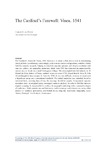Mostrar o rexistro simple do ítem
The cardinal's farewell: Viseu, 1541
| dc.contributor.author | Fonte, Carlos C. da | es_ES |
| dc.date.accessioned | 2014-10-02T12:32:03Z | |
| dc.date.available | 2014-10-02T12:32:03Z | |
| dc.date.issued | 2012 | es_ES |
| dc.identifier.citation | Culture of communication / Communication of culture, 2012: 1715-1721. ISBN: 978-84-9749-522-6 | es_ES |
| dc.identifier.isbn | 978-84-9749-522-6 | es_ES |
| dc.identifier.uri | http://hdl.handle.net/2183/13468 | |
| dc.description.abstract | [Abstract] The Cardinal’s Farewell: Viseu, 1541 Semiotics is rarely a first-choice tool in determining historical facts. Local history, contrastingly, with so many unresolved questions, could be a fertile field for semiotic research, helping to establish semantic patterns and observe evolution with time and culture. An epigraphic monument dated from 1541 has remained incomprehensible, known only to locals in a small Portuguese village. The transcripted text led initially to D. Miguel da Silva, bishop of Viseu, cardinal in pectore since 1539, chased then by King D. João III and thought to have escaped to Rome by 1540. It was very difficult, however, to assert such a hypothesis using only conventional methods. The initial suspicion was extended, based in historical facts, knowing that, if true, the message should be cryptic. Conjectured expected anomalies were investigated using convergent semiotic analysis, in order to find the intended original meaning. It was possible to confirm the epigraph’s authoring with a reasonable degree of confidence. Both semioticians and historians could encourage such interactions, using either analytic or synthetic approaches, and benefit in the long run. | es_ES |
| dc.language.iso | eng | es_ES |
| dc.publisher | Universidade da Coruña | es_ES |
| dc.title | The cardinal's farewell: Viseu, 1541 | es_ES |
| dc.type | info:eu-repo/semantics/conferenceObject | es_ES |
| dc.rights.access | info:eu-repo/semantics/openAccess | es_ES |






